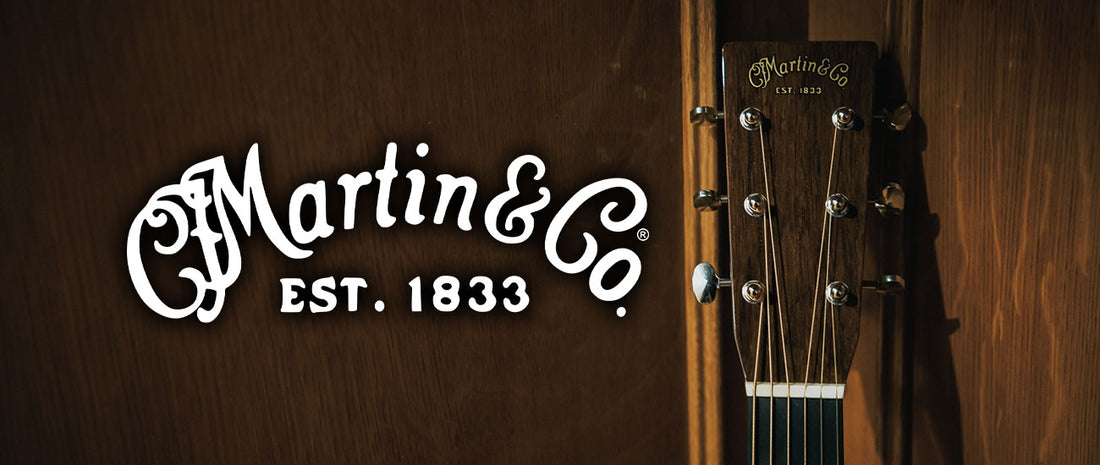

Old School? You could say so. You could also call C.F. Martin “O.G. of the American style Flattop Acoustic Guitar.” Martin’s history actually begins before the modern guitar, as we know it today. Christian Fredrik Martin (Sr.) developed a serious affection for building the still-developing instrument, during his apprenticeship in Europe’s strictly regulated Craftsman’s Guild.
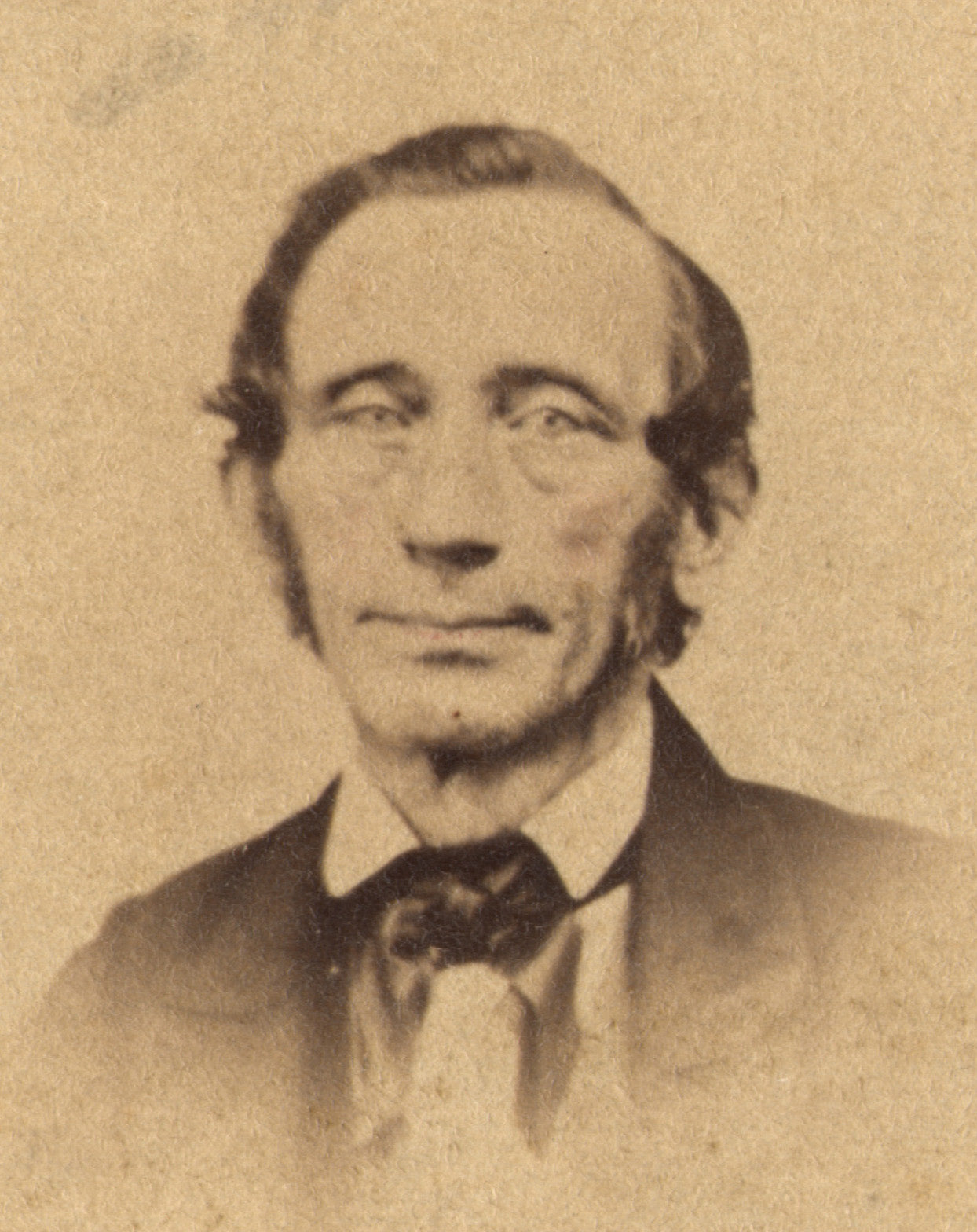
Christian Frederick Martin
At that time (around 1820), the Guitar itself was still a mix of the Lute, Mandolin, and small Baroque-era guitar. Shapes, sizes, and styles varied widely from country to country, and even region by region. Some designs featured 8 strings (like a bigger mandolin), while others had a single course of as many as 11 strings.
There was no definitive “Concert Masters” Guitar or even a Concert Master Guitarist. Regardless, the early Guitar was swiftly gaining popularity, for the same reasons the modern guitar is the people’s choice: The Guitar has a pleasing tone that’s capable of great expressiveness in the right hands- Plus, it’s portable, and easy to begin playing, due to its fretted neck. When Christian Frederick Martin started his apprenticeship, the up-and-coming guitar was not exclusively under the domain of any one Guild. The ‘snooty’ Violin Makers Guild wanted no part of the lowbrow, faddish instrument (something C.F Martin the 4th affectionately refers to as the “flea market Stradivarius”). When C.F. Martin finished his apprenticeship, the pesky Violin Guild had begun to see opportunity growing, with the Guitar’s rising popularity.
C.F. Martin & Co. Founded
Martin returned home from Vienna, fully prepared to make a name for himself as a fine Guitar maker. Unfortunately, for Martin, things had changed. The Violin Makers Guild changed their tune about the Guitar being a dying fad (not the last time the Guitar’s downfall was thought to be imminent).
After the Violin makers sued for exclusive rights to build the guitar, Martin faced some tough choices: Complete another long apprenticeship under the Violin Guild, stop building guitars, or skip town. Fortunately, Martin took his vision, skills, and family to the new world, where he laid the foundation for the American Style Flattop Guitar. C.F. Martin and his family arrived in N.Y.C. back in 1833 and set up shop building Stauffer and Baroque-style Guitars. After establishing clientele, supply chains, and distributors. C.F. Martin moved production to a town called Nazareth, in the Pennsylvania ‘Deutsch’ countryside. Today, Nazareth PA remains the beating heart of C.F Martin Guitars & Co, closing in a 200th anniversary (1833-2033).
Early C.F Martin Innovations
By 1850, the Torres Spanish Classical design (at least outwardly) helped standardize the basics we know as the modern Guitar. A course of 6 strings, tuned in fourths, a 24-26-inch scale length, circular sound hole, Gut strings, and a headstock with three tuning keys on each side. Across the Atlantic in America, C.F. Martin began to diverge and evolve independently from his mentor Johann Stauffer’s Viennese style, and the popular Torres Spanish classical style Guitarra. Starting from the inside out, Martin got to work, doing what he loved most-building a better guitar.
C.F. Martin and his family arrived in N.Y.C. back in 1833 and set up shop building Stauffer and Baroque-style Guitars. After establishing clientele, supply chains, and distributors. C.F. Martin moved production to a town called Nazareth, in the Pennsylvania ‘Deutsch’ countryside. Today, Nazareth PA remains the beating heart of C.F Martin Guitars & Co, closing in a 200th anniversary (1833-2033).
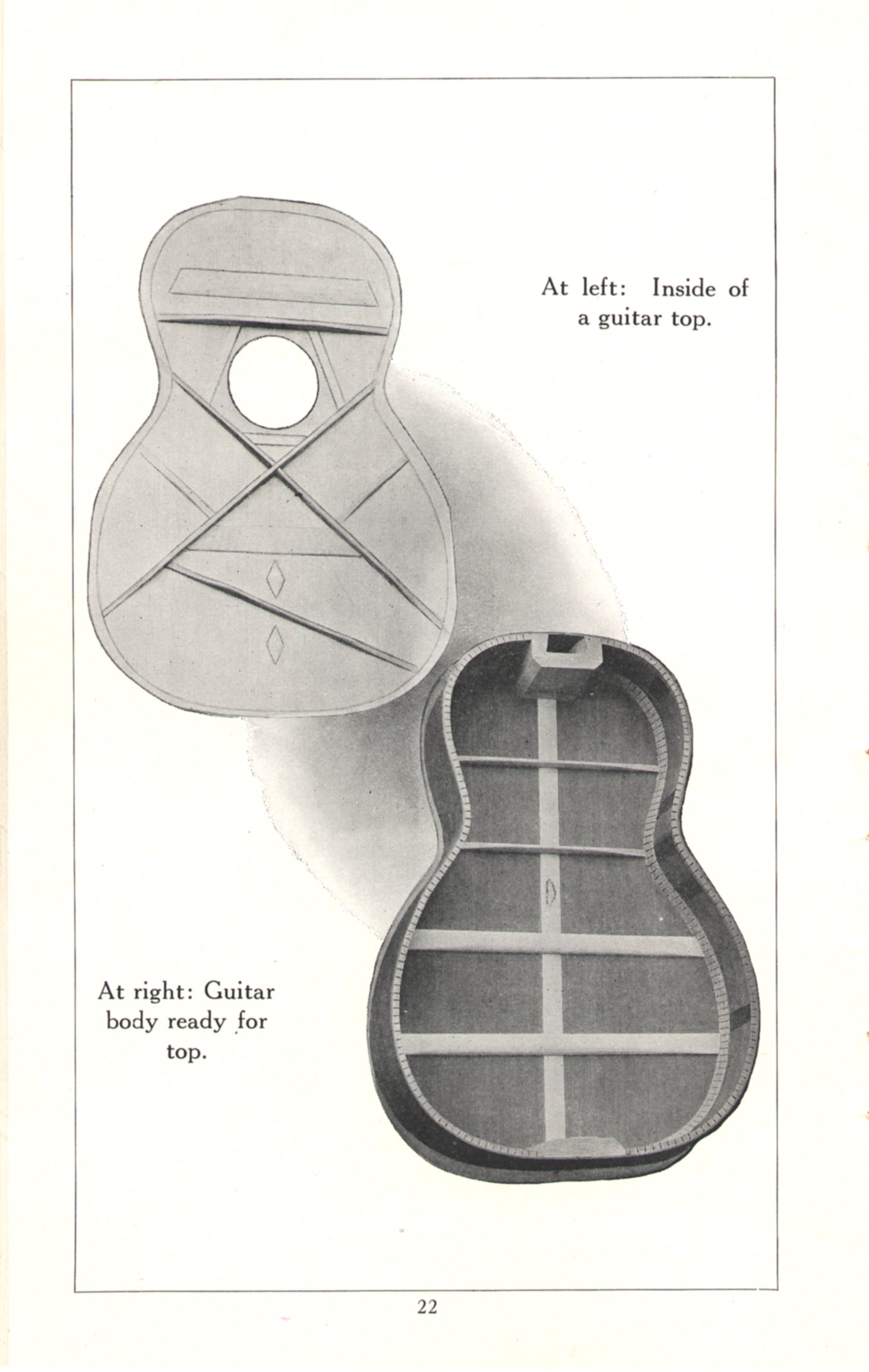
X Bracing Illustrated circa 1925
X Bracing
Several styles of style ‘X’ pattern top bracing were developed and deployed by Martin in the 1840s. The unique bracing system is both simple and complex: Two main support braces run diagonally, under the soundboard forming an X shape. The forward portion of the X surrounds the sound hole, while the rear section connects to the inner bridge plate. Resonance from the vibrating strings and bridge is very efficiently transferred throughout the entire sound box. This ingenious system produces a lively, open tone, without the dampening effect of ladder-style (straight) bracing. X bracing also provides far more support than the fan-style bracing used on the Torres-style “Spanish” Classical Guitar. By the end of the 1850s, X bracing was implemented on all C.F. Martin Guitars.
The Dovetail Neck Joint
Martin developed a unique and efficient neck/body joint, stylized like the Cabinetry Guild’s strong and reliable “Dovetail-joint.” It’s a radical departure from Martin’s earlier Stauffer style clock key, neck heel. It’s also a radical departure from the awkward to work with, delicate Spanish (classical) neck. In addition to supporting much greater tension, the dovetail joint helps resonance flow freely from the neck to the sound box, adding significantly more power and dimension. Driven by craftsmanship and innovation that can’t be seen from the outside, Martin’s unique and time-honored signature tone began to emerge. It’s often said that true beauty begins on the inside. For C.F. Martin, this continues to ring true: After 170 years, Martin’s signature “X-Bracing” remains the most widely used type of acoustic bracing system in the world. The Dovetail neck joint? Yup. Still a Hallmark trait of today’s highest-quality traditionally constructed Flattop Acoustic Guitars.
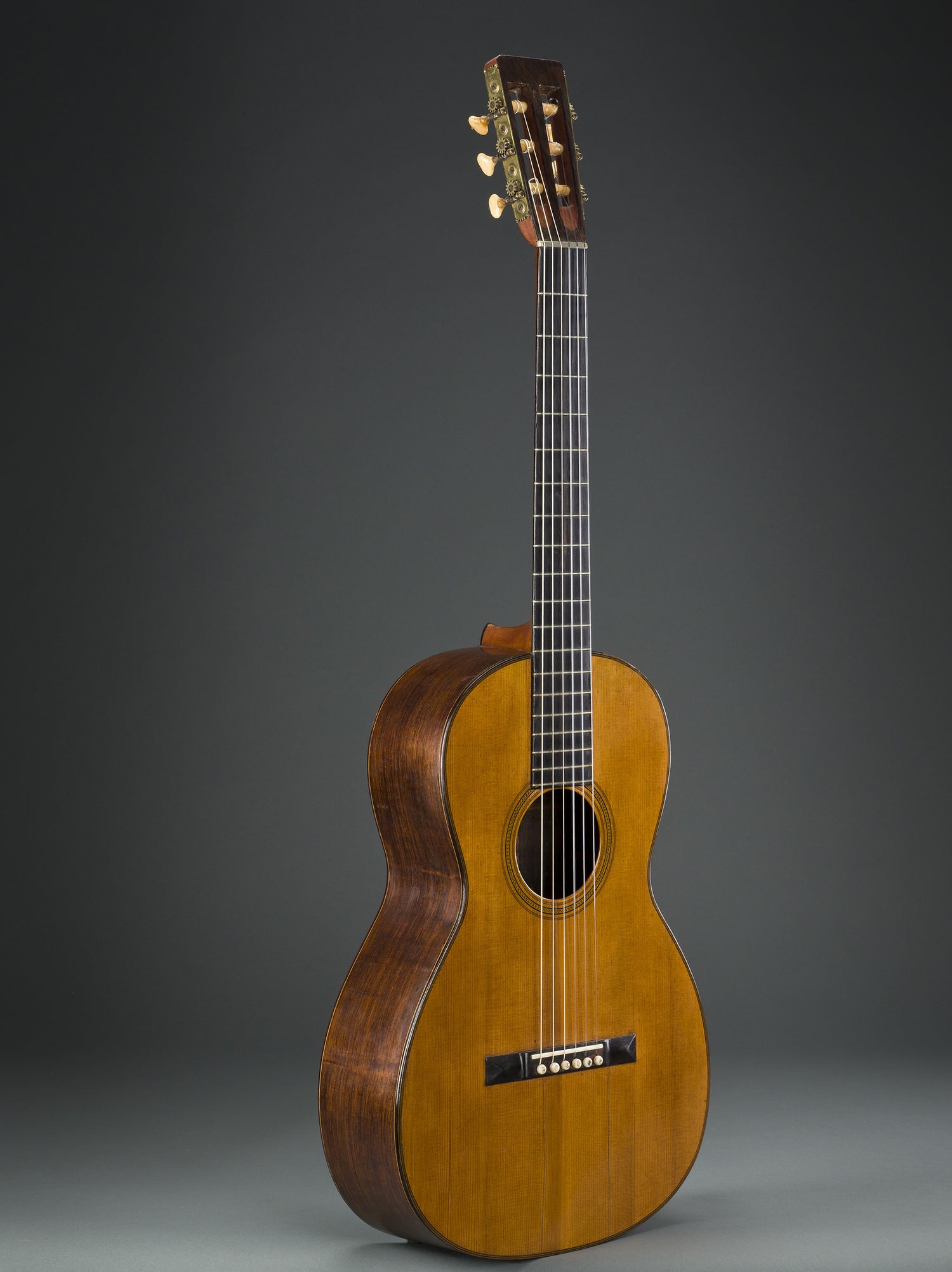
C.F. Martin size 1 made in 1846
The Early Martin American Style Flattop
Martin developed a standard line of Guitars in the 1850s. Naturally, models came and went, and specifications changed with the times, much like today. Martin guitars of the era were very small body instruments, designed for use with nylon (gut) strings. Martin Guitars range from short-scale, parlor-sized, and tiny-sized bodies like the Style 5, 2.5, 2, 1, and 0. The largest of the bunch was the diminutive size “0”. In 1898, C.F. Martin officially added the larger “00” size to the catalog. The 00 size is relatively small by today’s standards, but a sign of things to come.
By 1900, Martin had accumulated 67 years of know-how and produced approximately 10,000 Guitars. That’s an average of about 150 Guitars a year, but it belies Martin’s steady growth (Martin was producing as many as 300- 400 guitars per year by 1900). In today’s world, a 400 Guitar run is more like an extremely limited edition run, than an entire year’s output.
Each Martin Guitar was built by a small number of Craftsmen, without the benefit of today’s CNC machines or computer-controlled machinery to streamline, fine-tune, or quickly test new design concepts. Every tool, bench, and jig, needed for guitar making had to be purpose-built at the Martin factory- from simple hand tools to enormous wood-shaping steam presses (some of which are still in use today). Each new Guitar model and style needed to be completely designed from the ground up and ‘in the dark,’ so to speak. There simply were no ‘classic’ designs from which to draw inspiration.
The C.F. Martin guitar of the 1800s was not quite yet the Martin guitar we are all familiar with today. Aside from the smaller size, and nylon strings, all models featured a 12-fret neck (only 12-frets clear the body). By the turn of the century, Martin had been phasing out its smallest guitars, and ramping up production of larger guitars. Any model smaller than the ‘0’ slowly began to be fazed out, in favor of larger, louder sizes. With the 20th century on the horizon, C.F Martin was already a very well-respected American Guitar manufacturer, poised to become a legendary world-renowned institution.
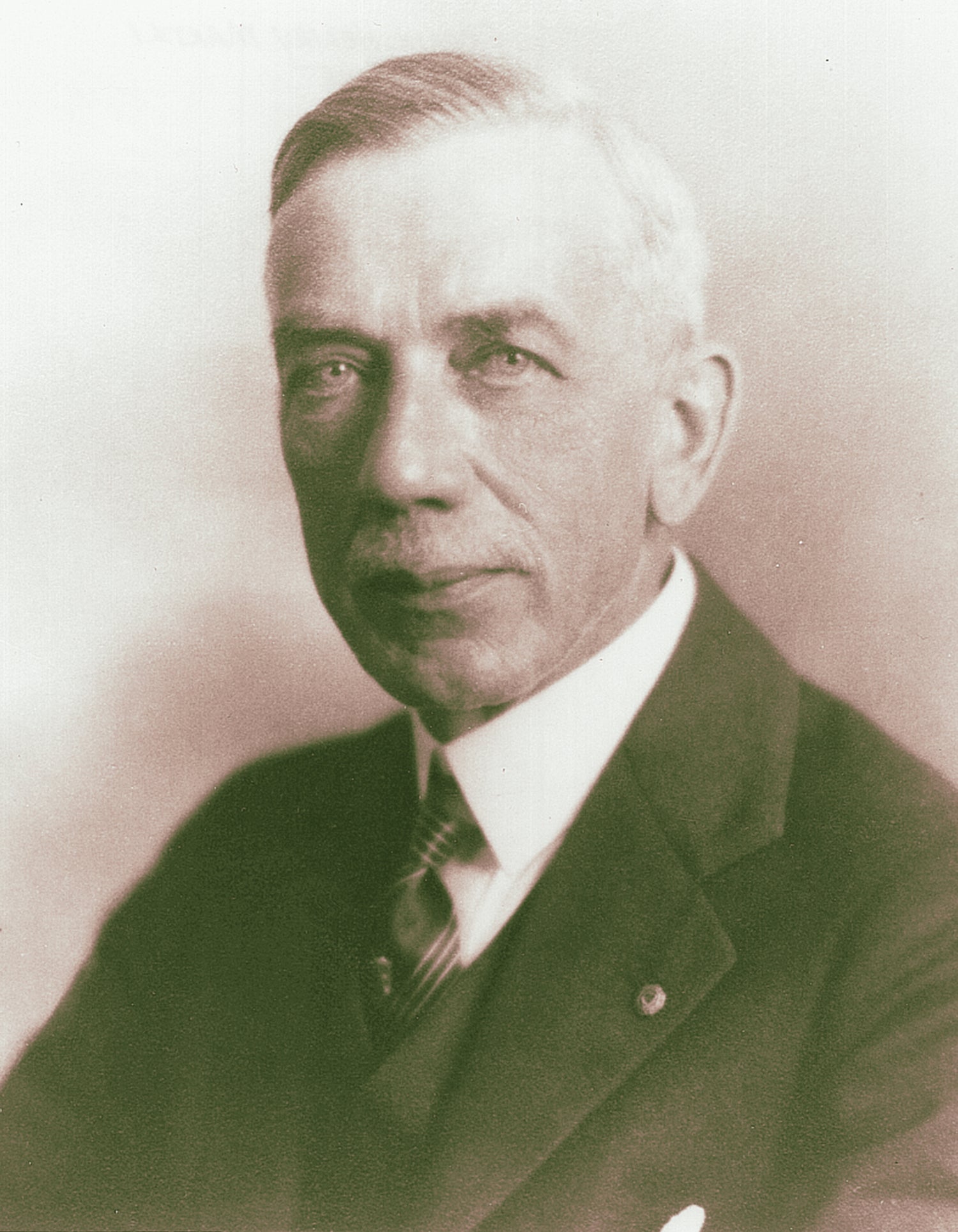
Frank Henry Martin
Part II 1898 The C.F Martin 20th Century Flattop
Christian Frederick Martin, company founder, and family patriarch died in 1873, leaving the company’s leadership in the well-groomed hands of his son, C.F Martin Jr. Unfortunately, after less than 20 years as Martin’s backbone, C.F Martin Jr. died suddenly in 1888. Leadership and the company’s future were passed to the skilled, but very young, 22-year-old Frank Henry Martin. It’s said that from strong people and hard work comes success. From success comes complacency, which comes before a fall. Fortunately, this was not the case. What the 22-year-old firebrand lacked in years of learned business acumen, was made up for with drive, ambition, and wisely instinctive decision-making.
Leading Martin Guitars into the 20th century will present challenges the likes of which his father and grandfather never dreamed of. Young F.H. Martin’s leadership was tested right out of the gate, when longstanding distribution partners in NYC officially cut ties, forcing Martin to self-distribute.
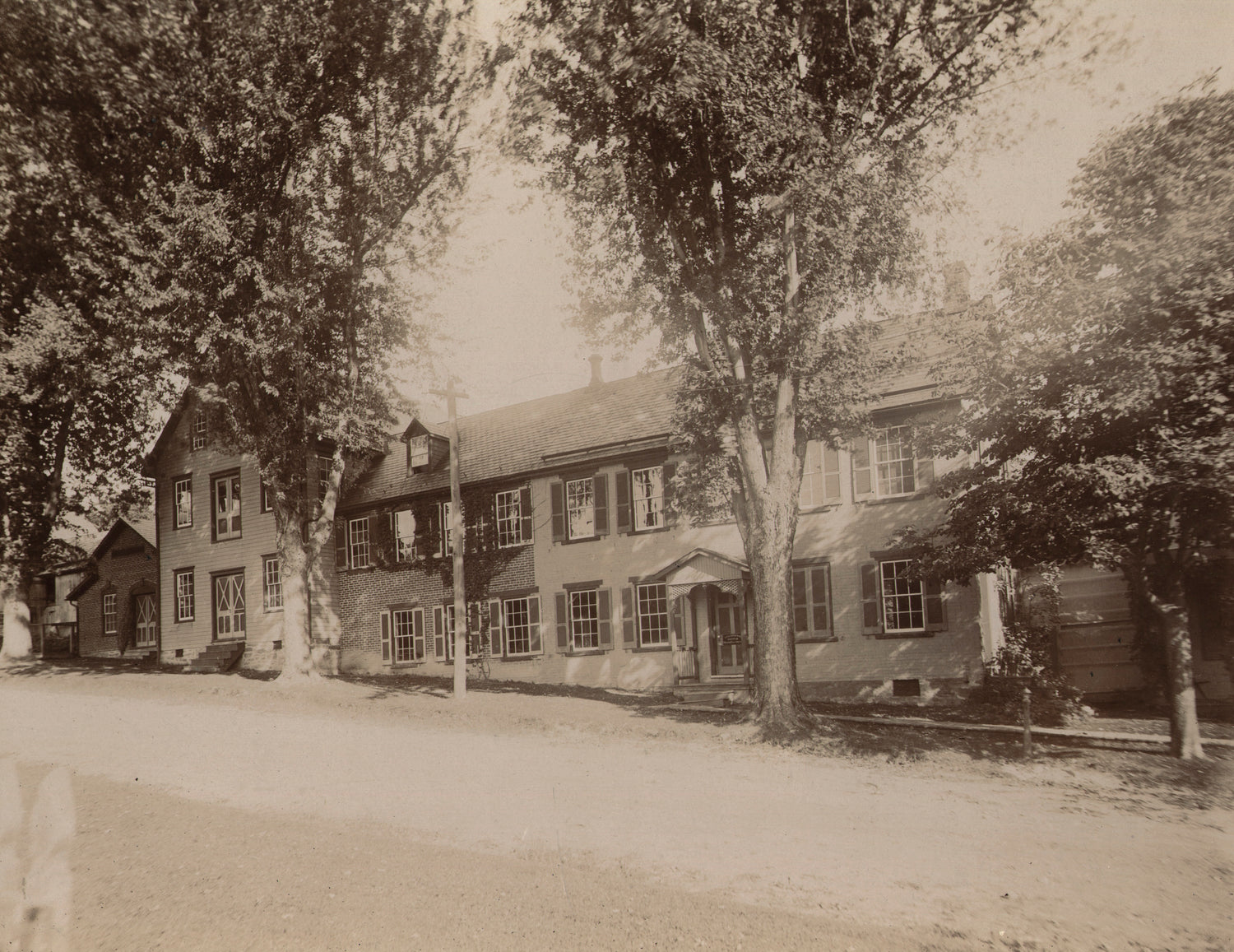
C.F. Martin North St Factory Circa 1900
Despite all the quick changes happening inside the C.F. Martin inner circle, the world outside Martin was changing even faster. The Guitar was growing in popularity, but the louder, more practical Banjo and Mandolin eclipsed the up-and-coming guitar by a wide margin. The strummed, 4-string (Plectrum and Tenor) style and Banjo are the undisputed Kings of the portable fretted instrument world. The Plectrum Banjo was played in just about every type and style of regional, and nationally popular music. The Banjo remained a mainstay in Jazz combos of the teens and early 1920’s-Even Louis Armstrong and his Hot-7 featured a Banjo player in the rhythm section. Although the American Guitar’s sweet tone and longer sustain would excel in every role the plectrum Banjo is used. Unfortunately, the Guitar just wasn’t loud enough.
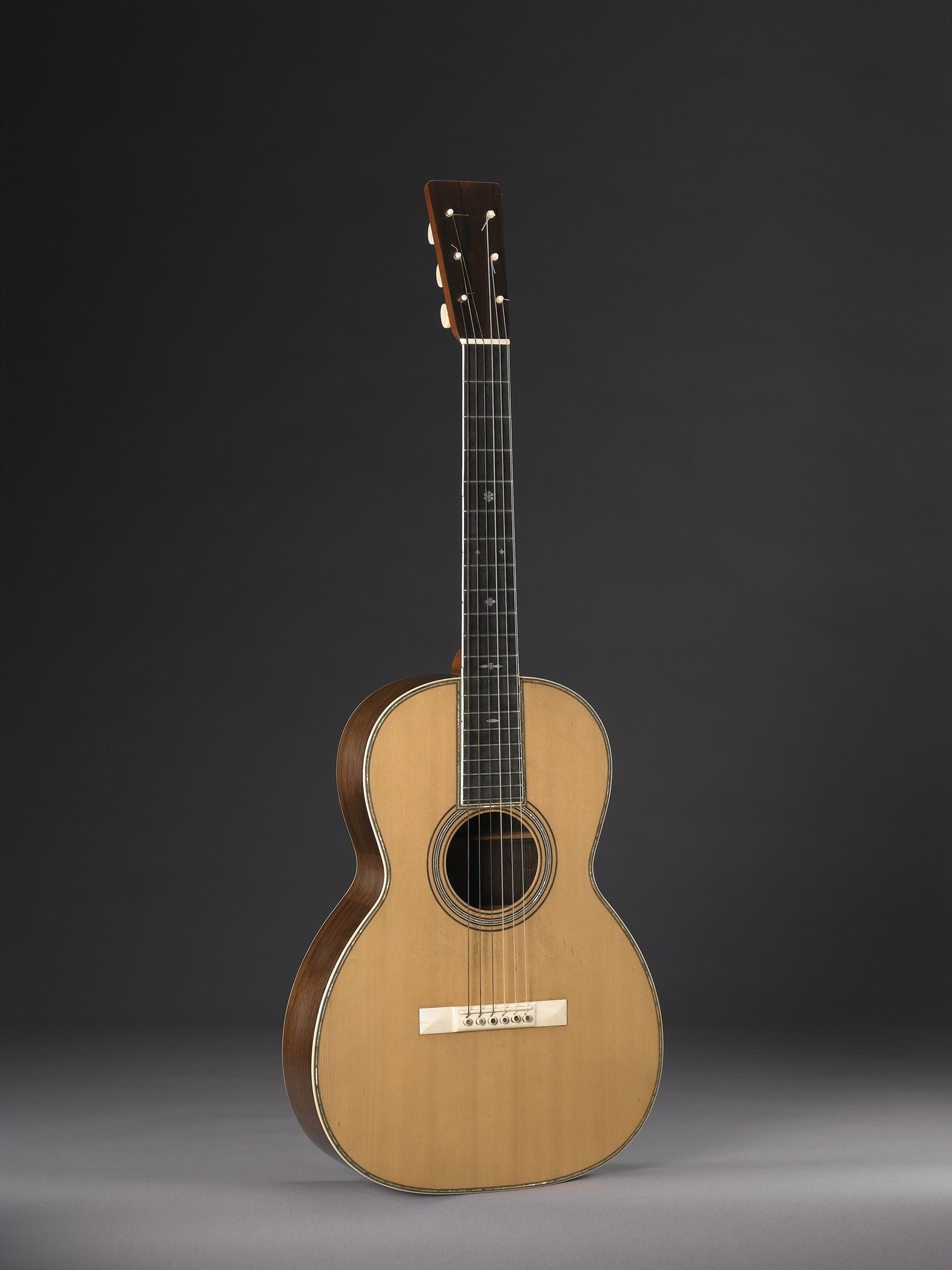
1902 Martin 00-42
The 20th Century Dilemma
The first two decades of the 20th Century sees a decline in Flattop Guitar sales. In the years leading up to W.W.1, Martin’s output trickles down to only a hundred or two Guitars a year. If Martin Guitars are to appeal to a wider range of musicians, reach its potential, or even maintain relevancy, the American Flattop needs to grow.
C.F Martin & Co is well aware that a bigger guitar is a louder guitar, but building a bigger guitar was anything but simple. If ever there was a time for the C.F. Martin Co. to re-invent itself as a Banjo maker, the time was ripe- Instead, C.F. Martin & Co decided it was time to re-invent the American-style Guitar. Under Frank Henry Martin’s leadership, Martin quietly began developing a new kind of guitar. One that’s versatile, pleasing, and loud enough to take on anything the briskly changing 20th Century brings. Many essential elements are already in place, but reinventing the C.F. Martin line of guitars will take over 20 years to complete.
At this point in history (Circa 1900), C.F. Martin has grown a well-known reputation for making uniquely American-style nylon string guitars of the highest quality. Other guitar builders of the times used multi-ply backs and sides and lower quality woods stained to look like Mahogany, Rosewood, or Ebony to cut costs. A placard on Frank Henry Martin’s desk read “Quality, not Quantity,” and he meant it. Martin’s Guitars, Mandolins and Ukulele’s constructed from all solid woods, utilizing only choice examples of Honduran Mahogany, Brazilian Rosewood, Adirondack Red-Spruce, and Hawaiian Koa. Consequently, C.F Martin’s clientele was made up of players willing to spend a little more money, to get the best possible instrument. Rushing a radical new steel string design with a less-than-stellar performance was a very real risk to Martin’s reputation. Moving too slowly with a 20th Century design could mean dwindling Guitar sales. Neither outcome is an option C.F. Martin & Co. would be likely to survive.
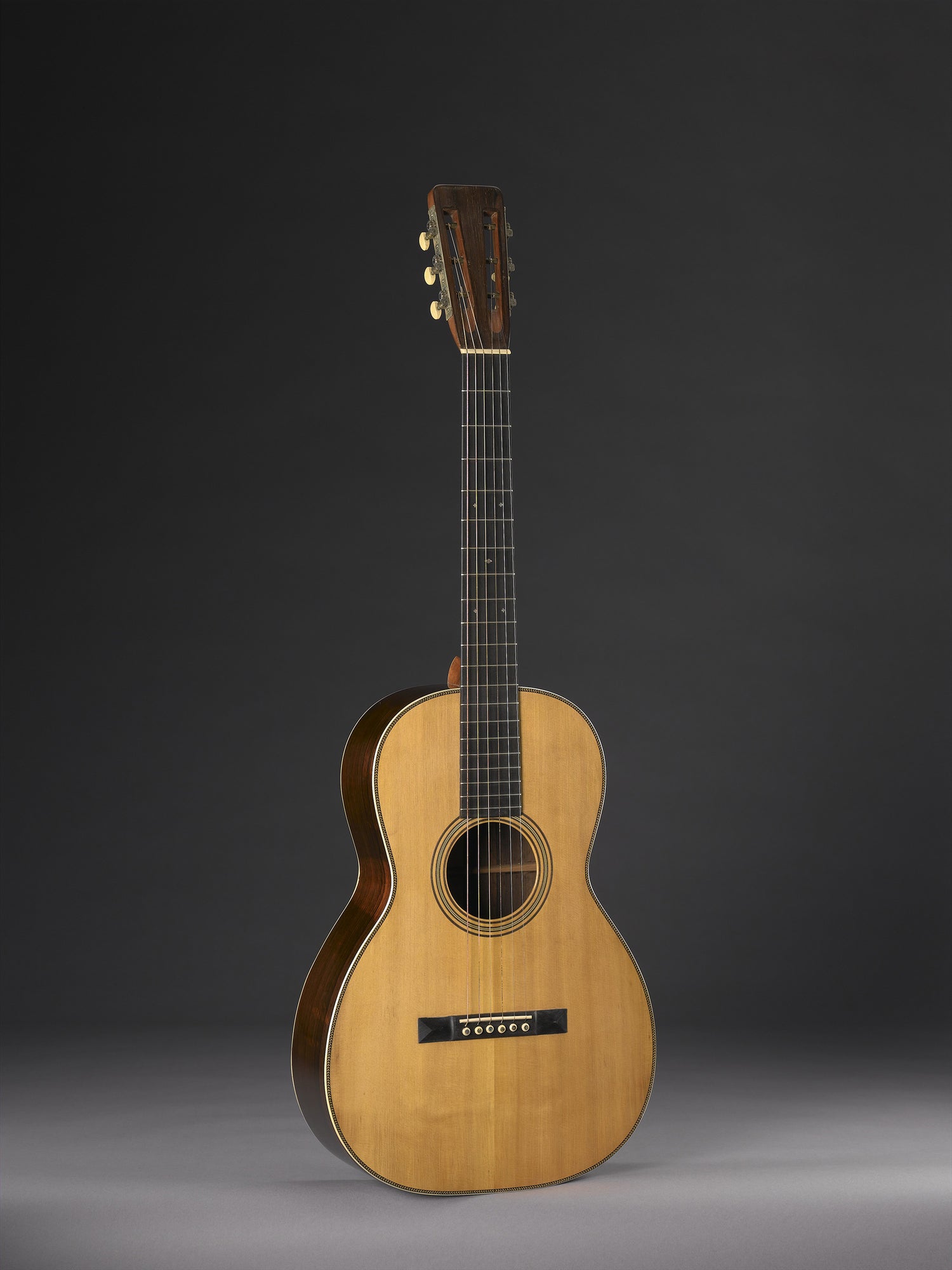
1915 C.F. Martin 0-28
C.F Martin Under Cover: Rolando and Ditson: 1916-1919
Under Frank Henry Martin’s ‘outside the box’ leadership, Martin began producing private label Guitars for the first time. Martin received orders for over 800 guitars between 1916 through 1919. The bulk of re-branded Martin Guitars went to high-end retailers like Southern California Music (re-branded as Rolando), and Boston-based Ditson (re-branded under the Ditson name).
Rolando and Ditson labeled guitar production added 1/3 of Martin’s overall guitar sales, adding tons of revenue during hard times. Still riding high on the wave of Hawaiian music’s explosive popularity, most of Rolando and Ditson’s order was specified to be regulated* for Hawaiian-style bar slide play. A factor that pushed C.F. Martin’s quiet development of the steel string Flattop acoustic, into overdrive. On this first venture into private-label Guitar manufacture, the C.F. Martin name does not appear anywhere on the instrument. This offered an anonymous way to test the new steel string design Martin has been quietly working on since the turn of the century.
The term ‘regulated,’ is an old-school way of saying “set up.” Regulated for Hawaiian style playing means high action (sometimes with flush frets, or adjustable nut height), and Steel Strings. Note: According to Jason Ahner at Martin, a steel and copper wound set was used for Hawaiian style Guitars, and steel and bronze wound was used for low action ‘Spanish’ regulated guitars and Steel-string Flattops.
Martin’s expansion/diversity: The Ukulele
To keep money flowing during the early 20th Century, Frank Henry Martin responded to the recent and explosive popularity of Hawaiian music and culture that swept across North America. Hawaiian musical influence crept into every type of mainstream American musical style. Suddenly, Hawaii’s Ukulele, and slide-style Guitar are the most popular flattop Guitars in the land. C.F. Matin’s carefully designed line of Hawaiian style Ukuleles has a superb, authentic sound quality, that very few if any rival. The highly desirable C.F. Martin Ukulele also helped preserve and grow Martins’s reputation for making fretted instruments of the finest quality.
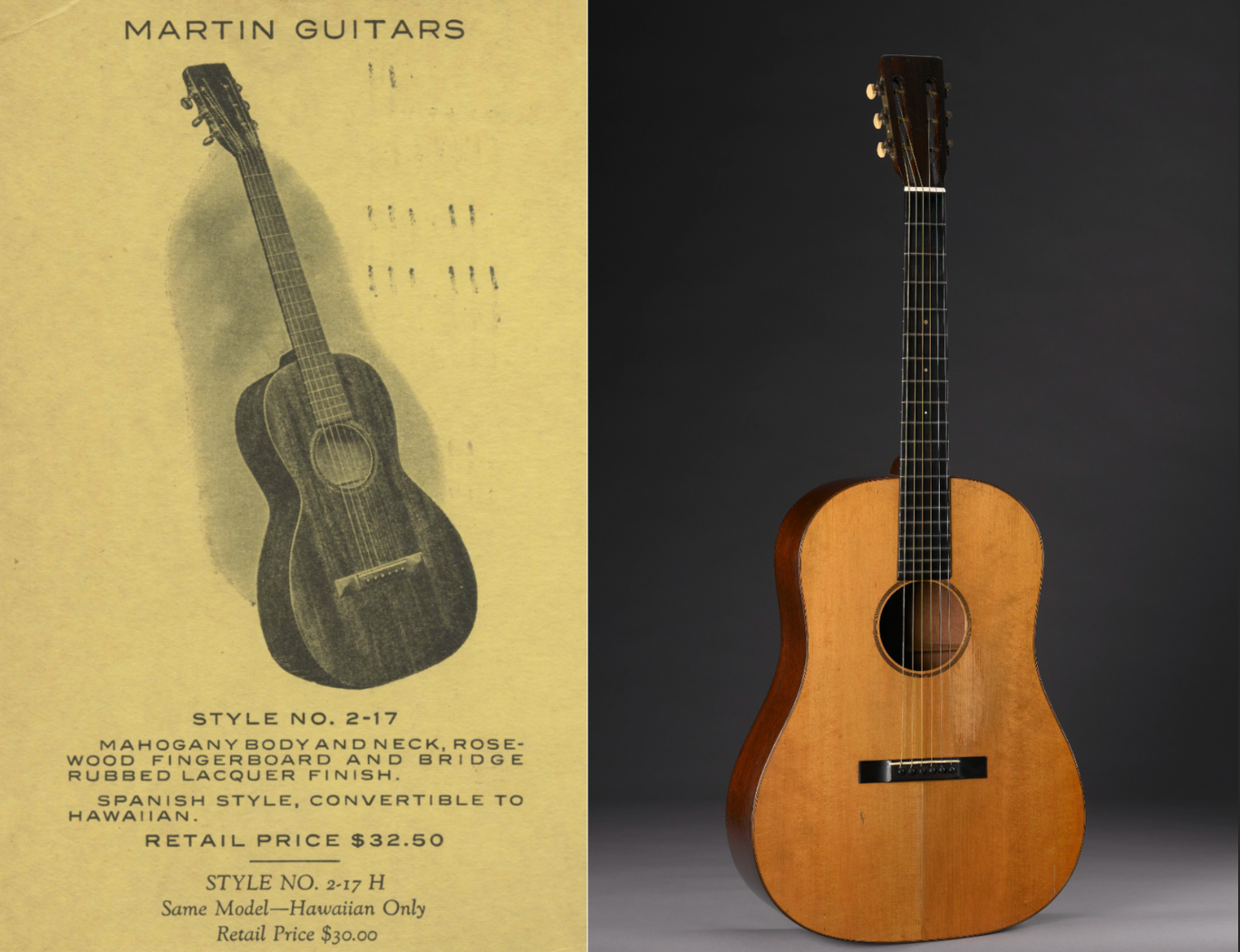
Print Add: Martin 2-17 (Martins's first Steel-String model) and 1929 “Ditson” Dreadnaught steel string guitars
C.F Martins 20th Century Solution: The Steel String American Flattop
The Model 2-17 is the first Steel string Flattop Guitar to boast C.F Martin’s logo. After all this time in development, why would Martin unveil its revolutionary new Steel-string Guitar in a tiny size 2, with the entry-level style 17 appointments? The answer is a simple one- Value/Price. The Steel-string Guitar design and its introduction methodology worked quite well. The model 2-17 ‘Steel String Spanish’ swiftly became one of Martins’s bestselling Guitars. What better way to entice plectrum Banjo players, and curious Guitarists than offering the new design at a price that’s hard to pass up?
As the 1920s progressed, most of Martin’s sizes and styles received the “steel string” construction makeover. Without Martin’s uncompromising designs and craftsmanship, the American style Flattop Guitar as we know it may have never been realized. In just 10 years (1922-1932), Martin fulfilled a staggering 36,000 Guitar orders. That’s nearly double the number of Guitars Martin built in its entire 88-year history. C.F. Martin’s re-invented 20th-century American Flattop Acoustic Guitar design is nearly complete.
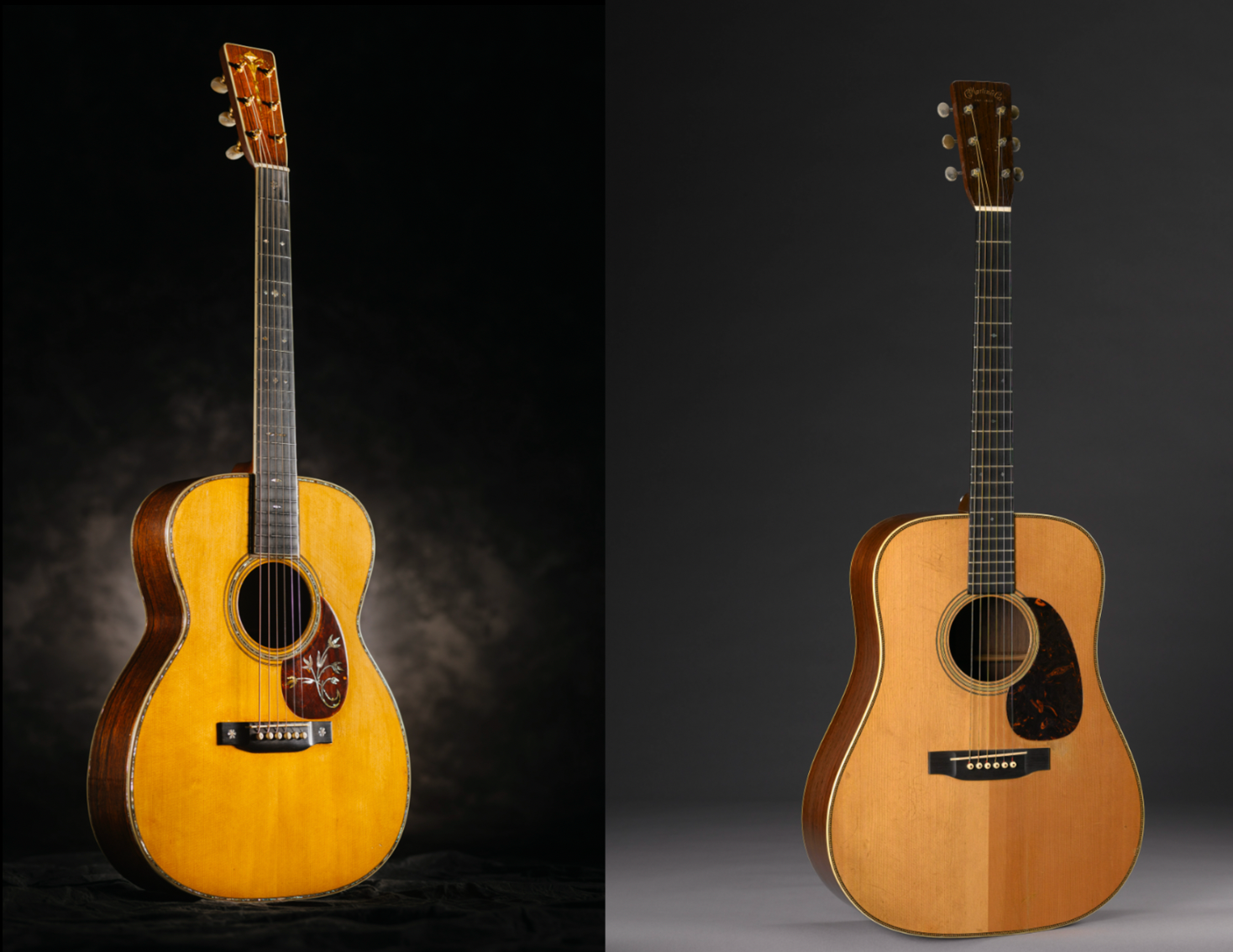
1930 C.F Martin OM-28 & The 1941 D-28
1930’s C.F Martin: The Great Steel-String Transition is Refined and Defined.
In 1929 Martin unveiled the OM-28, with its new 14-fret body style. The 1929 Dreadnaught reappeared as a 14 fret Guitar, in 1931. By 1934, the modern 14-fret Steel String design graced nearly every Martin Flattop size and style. Martin Flattop Guitars with a 14-fret neck/body joint developed in the 1930s are the classics that became the inspiration and template for the 20th century’s most common and well-loved Flattop shapes, styles, and designs.
The Modern C.F Martin Steel String Flattop Guitar Construction
Most Guitarists understand that attempting to put Steel strings on a Guitar constructed for gut/nylon string guitar leads to disastrous consequences. The average Nylon Sting Flattop can withstand about 70-85 pounds of string tension. A Steel string Flattop needs to withstand twice the amount of force (160lbs, or more). In more graphic terms- Attempting to use steel strings on Guitar constructed for Nylon/gut strings is an ‘explosive’ combination, likely to reduce your Nylon string guitar into a pile of wooden shards, with a tuner stuck in the drywall. Fortunately, C.F. Martin arrived prepared
The Dovetail neck joint C.F Martin Senior put into place in the 1800s was hearty enough to handle the additional tension of Steel Strings. Supporting the soundboard required some carefully designed modifications: An additional cross-body support, taller main braces, a wider bridge, and a thicker bridge plate provides enough strength and flexibility to handle the doubled string tension, but that’s just the beginning.
With steel strings in place, the power and rich tonal qualities are multiplied. The results produce a major lift in warmth, tonal complexity, and the essential power to change the role of the American Flattop acoustic guitar. The Steel-String Flattop Acoustic Guitar as we know it today, had finally arrived. Under Frank Henry Martin, the Co. C.F. Martin Co, successfully re-invented the guitar to meet the needs of the 20th Century musician. The new, uniquely American adaptation of the Spanish Guitar quickly began replacing the plectrum banjo as king of the fretted instrument domain, but the Guitar revolution is only beginning.
C.F Martin’s 20th Century Cultural Impact
Martin’s 20th century Guitar arrived at roughly the same time as the family Radio took on the role of the heart of the American home. Even in the dreadful depression era 1930s, nearly every household with electricity managed to save or barter into a family Radio. The sounds of Jimmy Rogers (Aka the Singing Brakeman, and ‘The Father of Country Music’) and his C.F. Martin guitar imprinted themselves on a nation of eager listeners.
Soon enough, singing Cowboy’s like Gene Autry and Roy Rogers packed the cinema. The early Hollywood Cowboy packed a 10-gallon hat, bed roll, and Henry Rifle, just as sure as a C.F. Matin Flattop. Gene Autry even had his name inlaid on the fingerboard. The story of America’s unique home-grown music styles like Blues, Jazz, Country, Western Swing & Blue Grass (just the tip of the iceberg) cannot be told without also including the American Style Guitar. Equally as true, the story of the American-style Guitar cannot be told without including C.F. Martin’s contributions to the instrument.
As the 20th century raced along, the guitar was embraced by each new generation, and cultural influence brewed in America’s melting pot of musical gumbo. C.F. Martin is intertwined with America’s culture, (and at times, counterculture). With the advantage of hindsight, it’s clear the Guitar provided much of the 20th-century American sound.
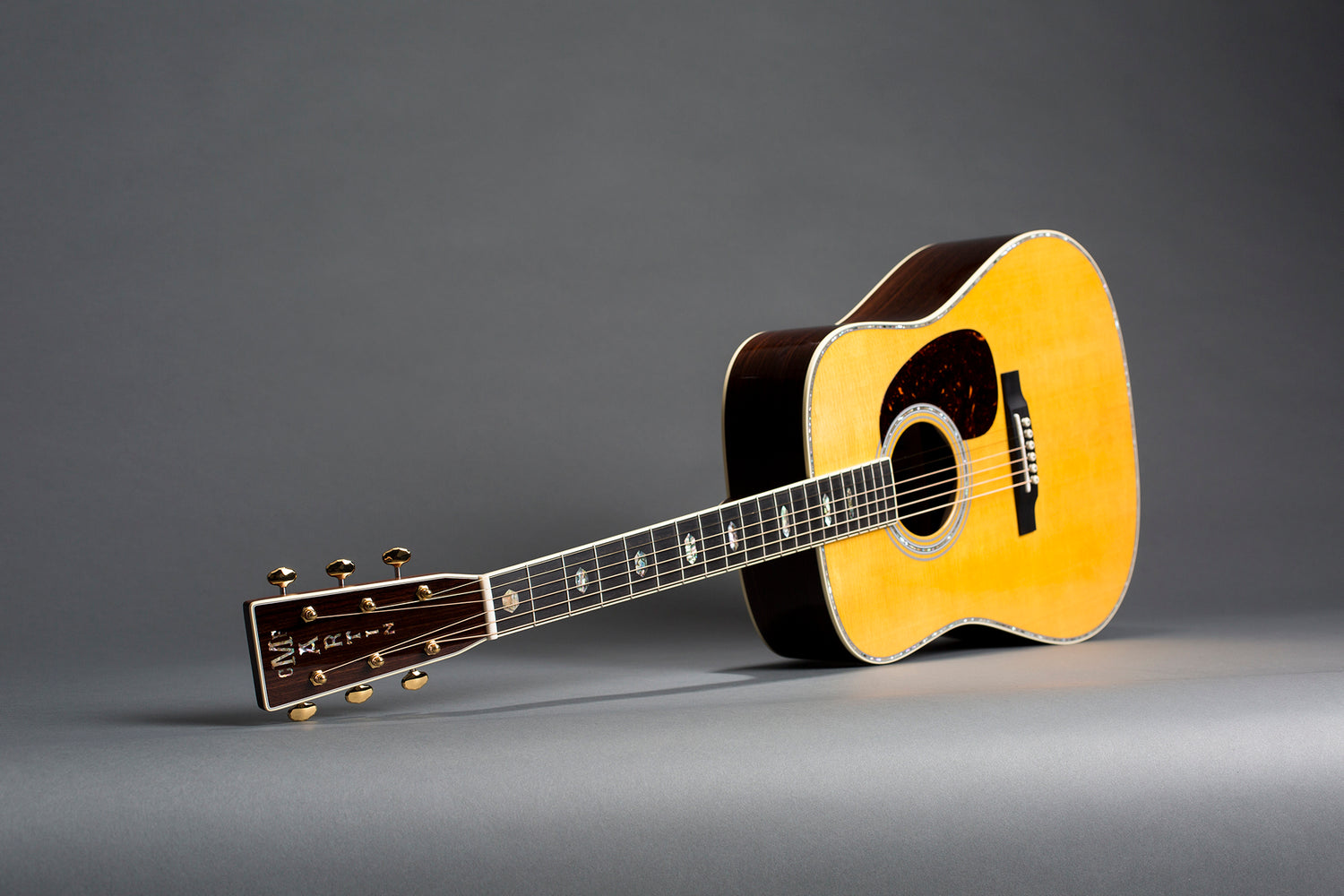
Modern C.F. Martin D-41
The C.F Martin Sound
Martin guitars from the 1930s are considered the pinnacle of flattop guitar manufacture, but their sound is directly connected with today’s Martin Guitar. In most cases, the same models of the Golden era are still available today and remain among Martin’s most popular. While each model has a distinct sound, and each guitar has a unique personality, the 1930s Martin sound can be heard within all of them. In a way, each Martin Guitar has a “family resemblance” that rings true across generations and decades-Keep that in mind the next time you stum a chord on a brand-new C.F Martin Guitar. The sound you hear is history. Describing ‘tone’ (especially in a truly detailed manner) is difficult, especially if you aren’t sure exactly what ‘warm’ or “complex overtones” sounds like. However, we’ll give it a shot.
Guitars made by C.F Martin share have an uncommonly rich and powerful low-end, well-defined midrange, and smooth highs, all in even balance. The sound is huge, but not overbearing. A C.F. Martin guitar is capable of delicate soft tones, as well as massive room-filling projection. Once you’ve heard a C.F. Martin guitar in the hands of a skilled player, you will remember the tone forever.
C.F. Martin’s Longevity, Relevance, and Growth
Another truly remarkable accomplishment of C.F Martin & Co is its longevity. Martin is a family-owned company that remains healthy, growing, and vital, going into its 19th decade. Very few companies share such resilience (especially under original ownership). C.F. Martin’s 20th-century Steel String Guitar has grown in popularity with each passing era, but it’s not always smooth sailing. Peaks and valleys in the Flattop’s Acoustic guitars popularity seem more like a roller-coaster, than a relaxing ride up an Alpine ski-lift. At the turn of the 20th century, Martin sold about 200-300 Guitars a year. By the mid-1920s Martin’s production ramped up to 5,000 guitars in a single year… That’s no simple increase. It’s 25X’s greater demand. With Martin approaching the 1930s and its “Golden age” what could go wrong?
Quite a lot: In 1929, the stock market crash threw a big wet rag on the roaring 20s, as America and the world entered the Great Depression. To make matters much worse, the world is at war again by 1939. C.F. Martin survived the civil war, the Great Depression, and two World Wars, simply by sticking to the plan-Make the best Guitar, not the most Guitars. After the war, production quickly returned to 1920’s highs, and beyond. Oddly enough, at times Martin’s sharply increasing popularity was to become its own greatest challenge.
The Chris Martin III era (1948-1986)
A diverse roster of influential Martin players like Bluegrass master Lester Flatt, Country Music Superstars Johnny Cash, and folk heroes like Woody Guthrie helped kick off Martin’s immediate post-war growth. Times and musical styles change more rapidly than ever before in history, but the Guitar remains the instrument of choice. Influential musicians of the late ’50s and early ’60s include Pop sensations the Kingston Trio, Rockers Buddy Holly and Elvis Presley, and Folk revivalist like Bob Dylan. Although worlds apart stylistically, they all share one common element-A love for C.F. Martin Guitars.
-
In 1964, 73 million of America’s youth tuned into the Ed Sullivan Show to see the American debut of the Beatles*. Guitar music is no longer swiftly gaining popularity- It’s an exploding phenomenon, that’s growing as fast as America’s youth.
-
In 1965, C.F Martin received orders for 7,500 guitars-A new all-time high.
-
In 1966, C.F. Martin took orders for a staggering 10,000 Guitars.
-
By 1971, C.F. Martin received orders for over 20,000 guitars.
Prosperous times that followed the war are largely responsible for what’s called the ‘Baby boom.’ A lopsided generation of young people born after WWII is the largest segment of the American population, by a factor of nearly 80%. By 1972, the average American is under 28 years old- a massive amount of people that came of age listening to music played on the guitar. Naturally, not all of America’s youth aspired to play the guitar, but it’s easy to imagine how demand for the Guitar reached all-time highs.
C.F. Martin’s ‘good fortune’ nearly broke its back. Peaking demand brought material shortages and intense competition. In the past Martin has always survived times like these by simply staying with the program: Make the best Guitar, not the most Guitars. At this time in history, it’s going to take more than making a few great Guitars each year for C.F. Martin to weather the storm. By 1982, Martin’s production slows to a trickle of only 3,100 Guitars. The company that makes America’s guitar went deeply into debt, and company morale is at an all-time low. Bankers are setting the table to feast on what’s left of C.F Martin’s assets, but all is not lost.
The Chris Martin IV Era: Re-inventing the C.F. Martin Experience (1986).
In 1986, Christian Fredrick Martin IV became Martin’s CEO. He is the Great, Great, Great Grandson of the founder. Chris the 4TH will need to make changes that will determine if he is remembered as C.F Martin’s greatest, or last leader. Chris the 4th is mild-mannered with a cool-headed, even temperament. He’s the kind of guy you might not suspect of being a bold, intuitive, fireball of a leader. Chris studied Business at Boston University, but most of his youth was spent in Martin’s factory learning the ropes from his grandfather. Chris is passionate about C.F. Martin guitars, and his amazing family legacy. In 1986, Chris the 4th took the leadership of C.F. Martin at 31 years of age. Being born in 1955, Chris is a part of the post-war population explosion that grew up listening to Guitar dominated music. Undoubtedly this gave Chris the 4th valuable perspective. Chris knew adjusting to the times was long overdue. By the late 20th Century, the Guitar’s role has changed, just as much as the people who play them. With that in mind, Chris found the answer to Martin’s problems, right under his nose.
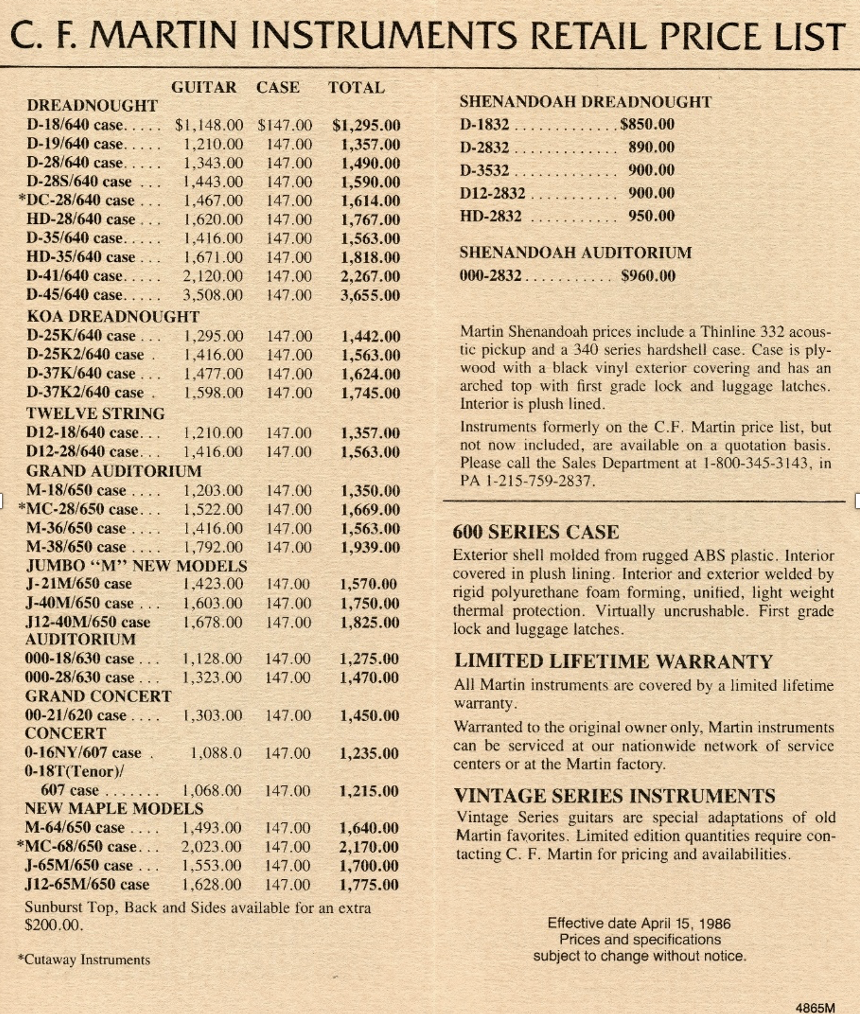
There is nothing in about Martin’s 1986 selection, or quality that jumps out as problematic. Most of Martin’s time-honored favorites are available, plus the recently unveiled Jumbo/M series, and new Maple body Jumbos. Some modernized designs from the late 1800s mark the beginnings of a re-issue program-Herringbone trim/scalloped bracing (HD style) that’s not been seen since the 40s is re-introduced on selected models-but nothing radical… Whats gone wrong??
What’s truly telling is what we don’t see: Something priced to serve the millions of young Americans that make up the majority of up-and-coming Guitarists. The HD-28 is among C.F. Martin’s most desirable models, and the 000-18 is the most affordable. Keeping in mind 80% of the guitar-buying public is 25 years old or younger, with an average income of about $4,000 a year. Adjusted for inflation, the HD-28 will set the Guitarist (or Mom and Dad) back about $5,000, while the 000-18 chimes in at over $3,600 -A nonstarter, for the vast majority of young guitarists.
The Alternative
Introduced in 1983, the Shenandoah by Martin line of Guitars is an attempt at offering a more affordable alternative. Although good quality imports (with final assembly done at the Nazareth factory) they have two crucial flaws: They aren’t genuine C.F. Martin-built Guitars, and they aren’t very competitively priced. The Shenandoah HD-2832 (the imported version of the HD-28) chimes in a whopping $2700.00 (adjusted for inflation).
Other alternatives: Since the early ’70s, demand for intermediate and affordable guitars skyrocketed. As a result, local musical instrument retailers are lined wall to wall with inexpensive imported Acoustic Guitars. Many of them are based on, if not outright copies of C.F. Martin favorites. Most of what is available are simple G.S.Os (Guitar-Shaped-Objects). Although some import alternatives are decent guitars, and some are quite good, none approach the Martin sound.
All but the very best of these imports are priced like a guided missile, aimed at a young person’s wallet. Although these cheaply put-together alternatives sell briskly, are they what’s hurting Martin’s sales? Probably not-The factor that’s always kept C.F Martin vital is quality of design and quality of manufacture. C.F. Martin’s Flattop Guitars are among the cream of the crop. Any decent up-and-coming guitarist can hear and feel the difference Martin’s quality delivers. For a bulging generation of young Guitarists, the C.F Martin sound is in demand, but out of reach. Pondering Frank Henry Martin’s ‘Quality not Quantity” placard, inspired answers. Surely quantity is relative to late 20th-century demand and can be delivered without a compromise in quality. Chris the 4th understood what needs to be done. It’s time for the C.F. Martin Co to re-invent the Guitar again.
The Modern C.F. Martin Guitar Company
We, Guitarists, have developed some funny quirks, irrational fears, and ‘superstitions’ over the years. Changes made to classic designs (no matter how small) are met with caution or outright disdain. For example, if Chris the 4th re-named the D-28, to D-29, but made NO OTHER CHANGES, panic would set in: “It’s just not the same!”, “My D-28 sounds better than any D-29!”, “What have you done!”. C.F. Martin could put a $100 gift card in the case flap of the fictitious D-29, as an instant rebate, but it wouldn’t help. Guitarists would line up to buy the final picked over D-28’s, at every far-flung Martin outpost- gift card be dammed! Exaggeration? If so, only slightly. If you’re a guitarist, you know it’s true. Chris the 4th is keenly aware of this bizarre quirk-A perfect example of understanding his generation. That being said, Chris finds himself bound by traditions that don’t allow the one thing that Martin needs: Change. Chris found a simple, but genius way to side-step tradition’s shackles by doing exactly what Frank Henry Martin did: Create new Traditions.
Not being a part of “golden era” expectations, the new “Style 16” has no real historical expectations to shatter. On the outside, the style 16 looks a lot like the style 18, but under the hood, it’s a whole different animal. The “Style-16” represents a blank slate that gives Chris IV some room to try new construction methods, woods, and some long overdue modernization. Best of all, the Style 16 delivers authentic Martin tone, at an affordable, midrange price point.
-
The Style 16 Experimental features:
Martins’s first guitar to feature an adjustable truss rod
- Sizes: Style 16s come in classic 000 and D sizes and the modernized 000C-16 (Cutaway) model
- Tonewood options: All Style 16s were solid wood construction, featuring a Sitka Spruce top. Back and sides woods include a choice of Mahogany, Walnut, and Koa. Fingerboard and bridge are made from Rosewood.
- Binding and finish: Satin finish with simple faux tortoise binding and scratch plate
- Construction: All solid woods, with scalloped forward shifted X-bracing, and Dovetail joint
- Fret Count: 20
- Neck: The style-16 is the first to feature the new low profile “Performance style neck”
The Performance neck is designed to take some of the labor out of playing an acoustic guitar. For a world full of players that grew up playing the soft-strung electric Guitar, it’s a welcome upgrade. A growing number of ‘electric only’ guitarists are lured back to the Acoustic Flattop. The ‘Performance’ neck contour is often noted alongside the Style number (Example: D-28P).
-
The Style 16 was first produced in 1986 but was not immediately a part of Martin’s USA catalog.
The Style-16 had some cost-cutting features (like a satin finish), and a slightly lower-tier wood selection than the style-18, to help cut costs*. The Style-16 remains C.F Martin’s experimental model, with unique new specification changes over the years. Every era of the style 16, represents the latest of C.F Martin’s experimental appointments. It's the one style in Martin’s lineup that represents change as a standard feature. Since 1986, over 150 different versions of the Style 16’s have been offered. Use your ears, not the spec sheet. No matter how different each Style 16 may be from the next, all sound like history.
*Martin grades Woods in 8 tiers. The best examples are used on styles like the 41,42 and 45, limited editions, Golden era, and the like. Any wood tier is worthy of Martin’s strict quality standards. Any wood that doesn’t pass inspection ends literary ends up in the dumpster or made into planters found all around the town of Nazareth. So, no matter what style Martin you own, or desire are all built from built the most premium woods available.
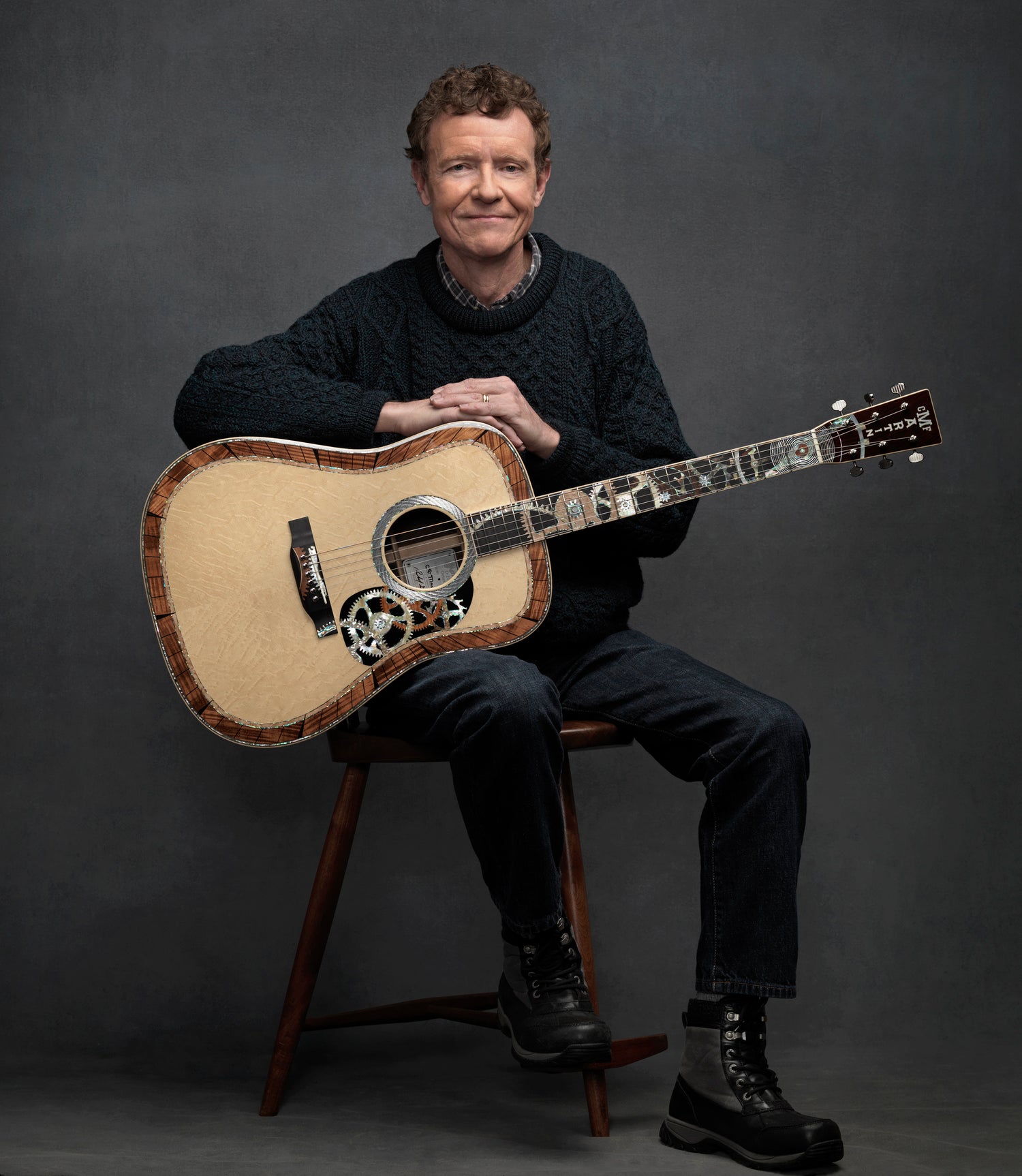
Chris Martin IV, 4th, holding the 2 Millionth C.F Martin Guitar.
Listing all of Chris Martin’s accomplishments is almost pointless: Not because any are too trivial to mention, but rather, because of the cumulative effect they’ve had on the company. The experimental, and intermediate-priced Style-16 saved C.F Martin from immediate peril, but it’s just a fraction of the welcome changes Chris the 4th brought to C.F Martin as a whole. When Chris took leadership, Martin had already shaped history and designed some of the most important guitars of the 20th century. One could say Chris saved the C.F Martin Co, by adding timely changes, not erasing the past. More accurately, one should say Chris Martin’s contributions helped C.F. Martin become something greater than they already were.
C.F Martin truly earned its moniker as ‘Americas Guitar’ by creating intermediate, and entry-level guitars, affordable to all without sacrificing an ounce of quality or integrity. Chris also expanded performance-oriented models, presentation-worthy collectibles, and long overdue artist signature editions. C.F Martin under Chris the 4th is now an example of excellence that is ‘all-inclusive’, in its best broadest sense. Between 1833 and 1983, C.F. Martin produced approximately 470,000 over its first 150 years. guitars. Only 20 years later, the Millionth Martin guitar was completed (2004). If that’s not amazing enough, C.F. Martin completed its 2nd millionth guitar in 2016. As of 2023, C.F. Martin is well on the way to its 3rd millionth Guitar.
Christian Fredrick Martin the 1st and Frank Henry Martin would be proud-There is nothing wrong with quantity as long as quality remains at the top of the checklist. At the rate C.F. Martin is growing, it’s evident everything remains “well regulated.” Alto Music is very proud to be a C.F. Martin dealer. Many of us are also proud C.F. Martin owners. We’d love to help you choose the Martin that’s right for your current needs or wants. We’ve got you covered- If you are seeking a first guitar, classic model, performance guitar, or collection-topping heirloom. If you want to know more about C.F. Martin guitars, we recommend visiting us. Sit down with any Martin guitar in our massive inventory, strum a chord, and hear history ring.
-
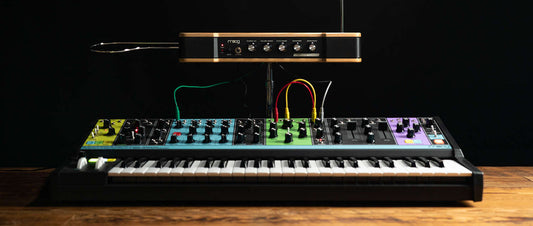
The Impact of the Moog Theremin: A Brief History
The Theremin was invented around 1920 by Soviet Russian Scientist Leon Theremin. His creation was probably the first musical instrument that had no “acoustic” ancestors and definitely the first musical...
The Impact of the Moog Theremin: A Brief History
The Theremin was invented around 1920 by Soviet Russian Scientist Leon Theremin. His creation was probably the first musical instrument that had no “acoustic” ancestors and definitely the first musical...
-

Choosing the Right Gibson Acoustic
Choosing a Gibson was your first great move. Every Gibson acoustic guitar made today, is a direct descendant of the groundbreaking designs of the 30’s through the 60’s. Gibson has...
Choosing the Right Gibson Acoustic
Choosing a Gibson was your first great move. Every Gibson acoustic guitar made today, is a direct descendant of the groundbreaking designs of the 30’s through the 60’s. Gibson has...
-

Yamaha Musical Instruments: Empowering Music Cr...
Torakusu Yamaha the businessman, engineer, traditional and progressive minded genius made himself and the world a promise. He will bring the power and means to make music Traditional value and craftsmanship working...
Yamaha Musical Instruments: Empowering Music Cr...
Torakusu Yamaha the businessman, engineer, traditional and progressive minded genius made himself and the world a promise. He will bring the power and means to make music Traditional value and craftsmanship working...



